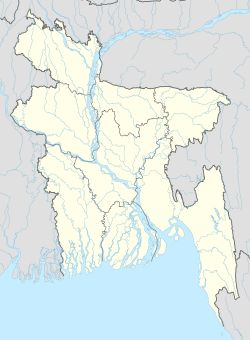world.wikisort.org - Bangladesh
Tala (Bengali: তালা) is an upazila of the Satkhira District in the Khulna Division of Bangladesh.
This article needs additional citations for verification. (September 2015) |
Tala
তালা | |
|---|---|
Upazila | |
 Tala Location in Bangladesh | |
| Coordinates: 22°45′N 89°15′E | |
| Country | |
| Division | Khulna Division |
| District | Satkhira District |
| Area | |
| • Total | 344.15 km2 (132.88 sq mi) |
| Population (2001) | |
| • Total | 299,820 |
| • Density | 870/km2 (2,300/sq mi) |
| Time zone | UTC+6 (BST) |
| Climate | Aw |
| Website | tala |
Geography
Tala is located at 22.7500°N 89.2500°E and has a total area of 344.15 km2.
History
Tala was established in 1913 and made an upazila in 1983.[1]
Demographics
According to the 2011 Bangladesh census, Tala had a population of 299,820. Males constituted 49.83% of the population and females 50.17%. Muslims formed 73.46% of the population, Hindus 25.76%, Christians 0.62% and others 0.16%. Tala had a literacy rate of 50.88% for the population 7 years and above.[2]
As of the 1991 Bangladesh census, Tala has a population of 251388. 51.31% of the population is male, and 48.69% is female.[3]
Administration
Tala Upazila is divided into 12 union parishads: Dhandia, Islamkati, Jalalpur, Khalilnagar, Khalishkhali, Khesra, Kumira, Magura, Nagarghata, Sarulia, Tala, and Tentulia. The union parishads are subdivided into 150 mauzas and 229 villages.[4]
Education
According to Banglapedia, Kumira Multilateral High School, founded in 1902, is a notable secondary school.[1]
See also
- Upazilas of Bangladesh
- Districts of Bangladesh
- Divisions of Bangladesh
References
| Wikimedia Commons has media related to Tala Upazila. |
- Goldar, Ashraful Islam (2012). "Tala Upazila". In Islam, Sirajul; Jamal, Ahmed A. (eds.). Banglapedia: National Encyclopedia of Bangladesh (Second ed.). Asiatic Society of Bangladesh.
- "Bangladesh Population and Housing Census 2011: Zila Report – Satkhira" (PDF). Table P01 : Household and Population by Sex and Residence, Table P05 : Population by Religion, Age group and Residence, Table P09 : Literacy of Population 7 Years & Above by Religion, Sex and Residence. Bangladesh Bureau of Statistics (BBS), Ministry of Planning, Government of the People’s Republic of Bangladesh. Retrieved 17 December 2018.
- "Population Census Wing, BBS". Archived from the original on 2005-03-27. Retrieved November 10, 2006.
- "District Statistics 2011: Satkhira" (PDF). Bangladesh Bureau of Statistics. Archived from the original (PDF) on 13 November 2014. Retrieved 14 July 2014.

Другой контент может иметь иную лицензию. Перед использованием материалов сайта WikiSort.org внимательно изучите правила лицензирования конкретных элементов наполнения сайта.
WikiSort.org - проект по пересортировке и дополнению контента Википедии
